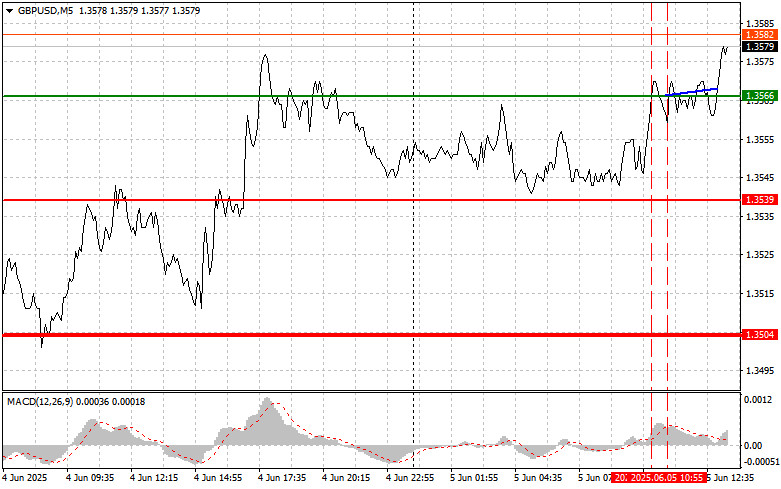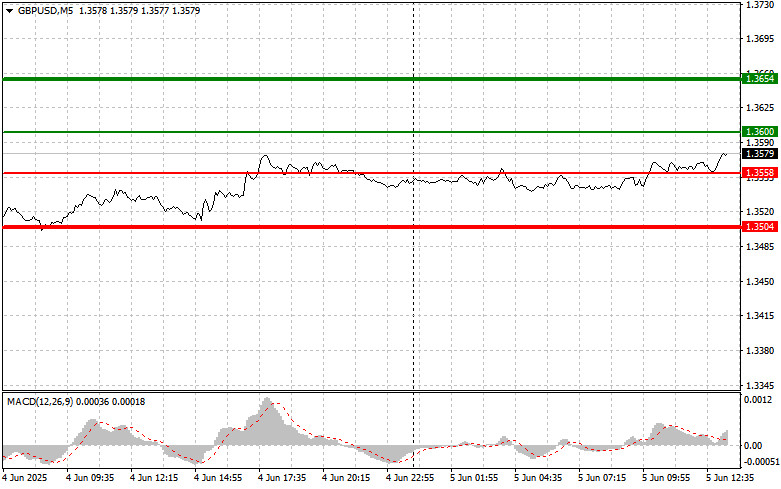Trade Analysis and Tips for Trading the British Pound
The price test at 1.3566 during the first half of the day occurred when the MACD indicator had moved significantly above the zero line, which limited the pair's upward potential. For this reason, I did not buy the pound. A second test shortly after became the reason for selling the pound under scenario #2, but a major decline in the pair did not occur.
Data on the U.K. construction sector activity for May supported the pound. The construction PMI, reflecting new orders and overall activity in the sector, showed good results, slightly easing fears of a slowdown in the country's economic growth. However, despite the positive signal, the pound has shown a restrained reaction, indicating ongoing uncertainty regarding the future prospects of the British economy. Positive data from the construction sector may only provide temporary support to the pound. The key factor determining the pound's medium-term dynamics will remain the interest rate differential between the U.K. and other major economies, as well as the U.K. economy's ability to adapt to new conditions amid U.S. trade tariffs.
In the second half of the day, the probability of significant market changes increases after the release of U.S. initial jobless claims and changes in nonfarm labor productivity. The main focus will be on the number of initial jobless claims, reflecting the current state of the labor market. A sharp increase in this figure could indicate a slowdown in economic growth, layoffs, and a general decline in business activity. Investors perceive this as a signal to reduce risky assets and shift toward more conservative strategies.
As for intraday strategy, I will mostly rely on implementing scenarios #1 and #2.
Buy Signal
Scenario #1: Today, I plan to buy the pound upon reaching the entry point around 1.3600 (green line on the chart) with the target of rising to 1.3654 (thicker green line on the chart). Around 1.3654, I plan to exit the buy trades and open sell positions in the opposite direction (targeting a 30–35 point move in the opposite direction). Pound growth today can be expected only after weak U.S. data. Important! Before buying, make sure the MACD indicator is above the zero mark and just starting to rise from it.
Scenario #2: I also plan to buy the pound today in the case of two consecutive tests of the 1.3558 level, at a moment when the MACD indicator is in the oversold zone. This will limit the pair's downward potential and lead to a market reversal upward. Growth can be expected toward the opposite levels of 1.3600 and 1.3654.
Sell Signal
Scenario #1: I plan to sell the pound today after the 1.3558 level (red line on the chart) is updated, leading to a quick decline in the pair. The key target for sellers will be the 1.3504 level, where I plan to exit the sell trades and immediately open buys in the opposite direction (targeting a 20–25 point move in the opposite direction). Sellers will show themselves in case of strong U.S. data. Important! Before selling, make sure the MACD indicator is below the zero mark and just starting to decline from it.
Scenario #2: I also plan to sell the pound today in the case of two consecutive tests of the 1.3600 level, at a moment when the MACD indicator is in the overbought zone. This will limit the pair's upward potential and lead to a market reversal downward. A decline can be expected toward the opposite levels of 1.3558 and 1.3504.
What's on the Chart:
- Thin green line — entry price for buying the trading instrument;
- Thick green line — suggested price for placing Take Profit or manually locking in profits, as further growth above this level is unlikely;
- Thin red line — entry price for selling the trading instrument;
- Thick red line — suggested price for placing Take Profit or manually locking in profits, as further decline below this level is unlikely;
- MACD indicator — when entering the market, it is important to consider overbought and oversold zones.
Important: Beginner Forex traders must be very cautious when deciding to enter the market. Before the release of important fundamental reports, it is best to stay out of the market to avoid being caught in sharp price swings. If you decide to trade during news releases, always set stop-loss orders to minimize losses. Without stop-loss orders, you can very quickly lose your entire deposit, especially if you do not use money management and trade with large volumes.And remember, for successful trading, you must have a clear trading plan, like the one presented above. Spontaneous trading decisions based on the current market situation are initially a losing strategy for an intraday trader.













